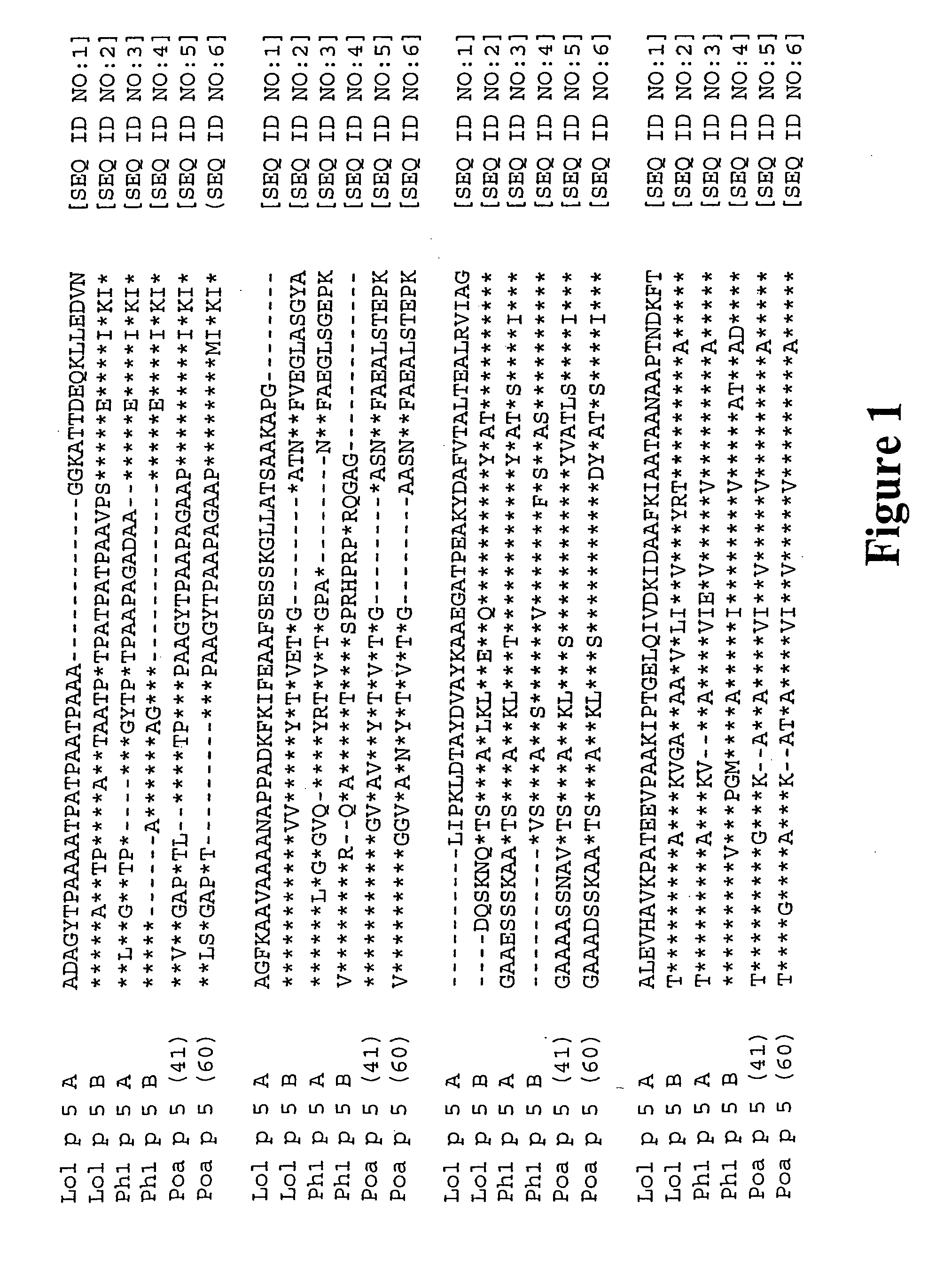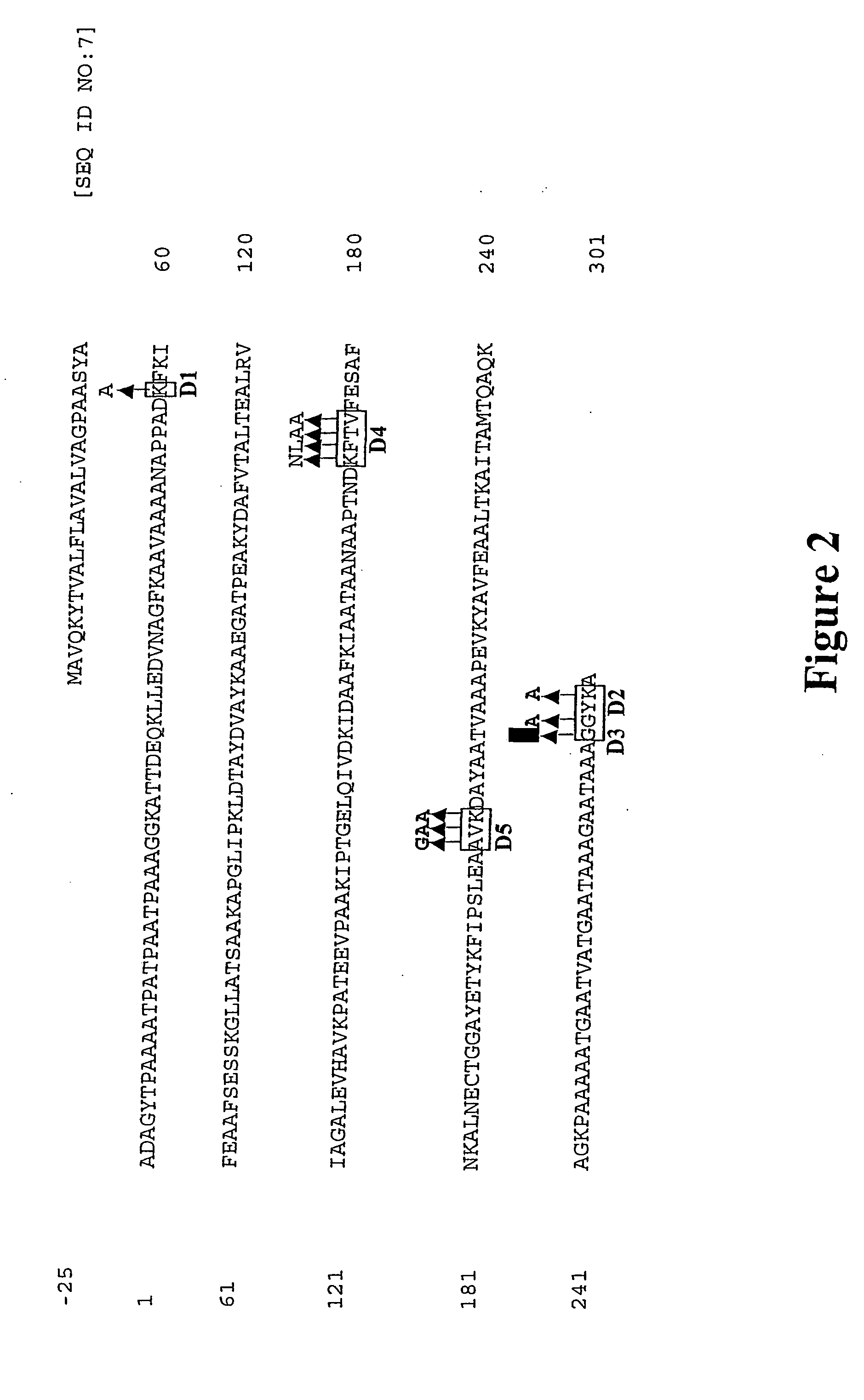Recombinant allergen with reduced ige binding but undiminished t-cell antigenicity
a technology of recombinant allergens and antigenicity, which is applied in the field ofreagents useful, can solve the problems of high anaphylaxis index, and achieve the effects of reducing the binding capacity of ige, reducing the production-stimulatory activity of ige, and prophylaxis or treatmen
- Summary
- Abstract
- Description
- Claims
- Application Information
AI Technical Summary
Benefits of technology
Problems solved by technology
Method used
Image
Examples
example 1
Generation of Lol p 5 Mutant Proteins
[0095] To engineer hypoallergenic, non-IgE reactive allergen variants, it was required to be determined whether key residues of the proteins can be selected which can be changed while keeping the general structure and T-cell epitopes intact. Since the highest frequency of IgE binding is observed in peptide fragments which span the C-terminal half of Lol p 5, the inventors introduced mutations predominantly in the C-terminus of the allergen. To identify amino acid positions in Lol p 5 likely to have an influence on the IgE intereactivity of the protein, protein sequences of isoform A and B of Lol p 5 were compared with group 5 allergens of other grasses (FIG. 1). Site-directed mutagenesis was employed to replace residues that are highly conserved among group 5 allergens (FIG. 2). Mutant proteins altered in one or three domains were generated (FIG. 3).
[0096] Non-mutated Lol p 5 and mutated variants of Lol p 5 were expressed in soluble forms in E....
example 2
Expression and Purification of Recombinant Lol P 5 and Mutant Proteins
[0097] The coding sequences of Lol p 5 and the mutant proteins were introduced in-frame into the expression vector pQE31 (QIAGEN). The vector allows expression of recombinant proteins with an N-terminal, 6-residue histidine tag. Expression and harvesting of the proteins was carried out as outlined in the QIA expressionist manual. Histidine-tagged proteins were purified using TALON metal affinity resin (Clontech), following the procedure for batch / gravity flow column purification as outlined in the TALON Metal Affinity Resin user manual (Clontech).
example 3
SDS-Page and Western Blotting
[0098] For SDS-PAGE, 1.3 Fg of Lol p5 and each of the mutant proteins were boiled for 5 minutes with 10× protein sample buffer. Samples were loaded onto a 15% w / v acrylamide mini gel at 200 V for 40 minutes in a buffer of 0.2 M glycine, 0.025 M Tris, 0.1% w / v SDS.
[0099] For staining, gels were shaken in 0.1% w / v Coomassie Brilliant Blue R250 for at least an hour. Gels were destained in 20% v / v methanol, 7% v / v glacial acetic acid, 3% v / v glycerol, overnight with two buffer changes.
[0100] Gels were western blotted in a BIORAD mini-Protean II cell western blot apparatus in a buffer of 0.025 M Tris, 0.2 M glycine, 20% v / v methanol onto Nytran 0.2 Fm nylon membrane (Schleicher & Schuell) at 100 V for 1 hour at 4° C.
PUM
| Property | Measurement | Unit |
|---|---|---|
| Sensitivity | aaaaa | aaaaa |
| Antigenicity | aaaaa | aaaaa |
Abstract
Description
Claims
Application Information
 Login to View More
Login to View More - R&D
- Intellectual Property
- Life Sciences
- Materials
- Tech Scout
- Unparalleled Data Quality
- Higher Quality Content
- 60% Fewer Hallucinations
Browse by: Latest US Patents, China's latest patents, Technical Efficacy Thesaurus, Application Domain, Technology Topic, Popular Technical Reports.
© 2025 PatSnap. All rights reserved.Legal|Privacy policy|Modern Slavery Act Transparency Statement|Sitemap|About US| Contact US: help@patsnap.com



